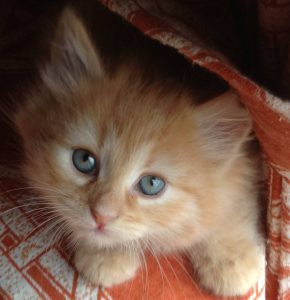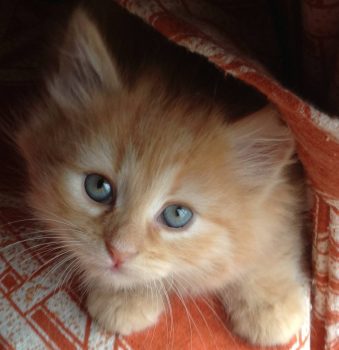Siberian Cats
The Siberian is a medium to large cat with the overall appearance of excellent physical condition, strength, balance, power, and alertness, with a sweet facial expression. Their eyes vary in color from gold to green and all shades in between. Some have two different colored eyes, and some even have blue eyes. Siberians are a natural breed and reflect the climate in which they developed, with their very dense, medium-to-long, water-repellent triple coat.
This coat is accented with a ruff around the neck, full fluffy britches, and a bushy tail, normally carried up with pride but also quite useful to wrap around the face and paws to keep warm. Lynx tipping on the ear is allowed, and full ear furnishings are required. This means that the tops of the ears can have hair, which makes the ears look pointed when in fact they are rounded, and that the inside of the ear has hair that protects it from the elements.
This glorious and quite useful fur comes in all colors and combinations, with or without white markings, and tends to remain relatively tangle-free, requiring only occasional brushing.
 This is a cat designed by nature to survive, with no extremes in type. The Siberian can take up to five years to mature, with females generally being smaller than males. The general impression of the body is one of circles and roundness, rather than rectangles and triangles.
This is a cat designed by nature to survive, with no extremes in type. The Siberian can take up to five years to mature, with females generally being smaller than males. The general impression of the body is one of circles and roundness, rather than rectangles and triangles.
Although it has not been proven scientifically, many people believe that the Siberian is hypoallergenic (see below). In fact, many allergy sufferers have a sensitivity to FelD1, and some Siberians have a lower than average occurrence of FelD1 in their saliva. When a cat licks its fur, the saliva dries and flakes to create the dander to which people are allergic. This can vary from cat to cat and person to person. Please see our Frequently Asked Questions page for info on allergy testing.
Siberian cats are very personable and want to be near their owners. They enjoy the company of children, dogs, and other animals. They are fearless and easygoing; not much disturbs their natural calm and equanimity. They seem to know when they are needed for psychological and moral support and spend time with the person who needs them most. They are a quiet breed that expresses themselves in a melodic way through sweet mews, trills, chirps, and lots of purring.
All types of toys intrigue them. Some learn to play fetch, while others are intrigued by the moving cursor on the computer screen or sit and watch, entranced, as you type. Acrobatic by nature, the Siberian will play hard, often executing amazing somersaults in pursuit of a feather toy. An over enthusiastic kitten may need to be rescued while attempting to climb the bricks on the fireplace or jumping to the top of a bookshelf. Siberians stay playful throughout their lives.
Breed History
The Siberian is a landrace variety of domestic cat, present in Russia for centuries, and more recently developed as a formal breed, with standards promulgated since the late 1980s.
They vary from medium to medium-large in size. A longer name of the formal breed is Siberian Forest Cat, but it is usually referred to as the Siberian or the Siberian cat. Another name for the formal breed is the Moscow Semi-Longhair. The cat is an ancient breed that is now believed to be ancestral to all modern long-haired cats. The cat has similarities with the Norwegian Forest Cat, to which it is likely closely related. It is a natural breed of Siberia and the national cat of Russia. While it began as a landrace, it is selectively bred and pedigreed today in at least seven major cat fancier and breeder organisations. The colourpoint variant of the breed is called the Neva Masquerade by some registries, including Fédération Internationale Féline (FIFé).
The cat was first mentioned in a book by Harrison Wier, which included information of the earliest cat shows in England in 1871. Siberians first arrived in the United States in 1990. Although the breed has gained popularity, the expense of importing the cats from Russia keeps them relatively rare outside of Europe.
–Extract from Wikipedia
Siberian Fur
Siberians express the three natural types of feline fur: guard hairs, awn hairs, and down. These layers protect the cat from Russian weather extremes and provide a hardy coat. The fur is textured but glossy, which decreases the occurrence of matting.
As with most other cat breeds, colour varieties of the Siberian vary and all colors – such as tabby, solid, tortoiseshell and colourpoint – are genetically possible. The Siberian cat breed does not have any unusual, distinct, or unique fur colourations or patterns.
Siberian cats moult once or twice a year. The first moult is at the end of winter. The winter moult is instigated not by a change in temperature but by a change in day length. Many Siberians will experience a less intense “mini-moult” at the end of the summer season, unlike other cats, which will experience a “heavy moult” more than twice a year.
–Extract from Wikipedia
Hypoallergenic
A not-for-profit association of breeders, Siberian Research Inc, was founded in 2005 to study allergen levels and genetic diseases in the Siberian breed. As of March 2010, fur and saliva samples from over 300 Siberians have been submitted for analysis, many directly from a veterinarian. Salivary Fel d1 allergen levels in Siberians ranged from 0.08-27 µg per ml of saliva, while fur levels ranged from 5-1300 µg. The high-end of these ranges is consistent with results from prior studies, though the low end is below expected results.
All Siberians tested were found to produce some Fel d1, with the highest levels being found in Siberians that have silver coloured fur. About half of Siberians were found to have Fel d1 levels lower than other breeds, while under twenty percent would be considered very low. Within the low group, males and females had comparable allergen levels.
–Extract from Wikipedia
So, if you’re allergic to cats, you may find you’re more allergic to the silver variety than the rest. We recommend getting an allergy test with us for £25, where you’ll sit with our adult cats for an hour in an enclosed outdoor summer house. Sitting with an adult cat is the best way to test for an allergy as the cats are fully grown and developed.

